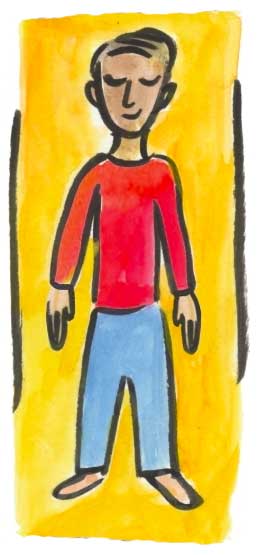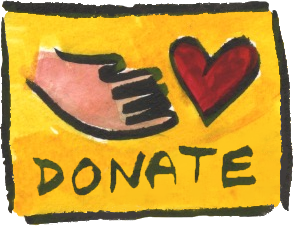
Getting Oriented
Welcome!
On behalf of our global listener community, and the donors whose generosity powers the Feldenkrais Project, we are glad you're here! We think it makes the world a kinder place when more people are learning how to move and feel better. In case you're wondering how to say it, Feldenkrais rhymes with "paradise"!
The Feldenkrais Method harnesses neuroplasticity, the brain's curiosity-based ability to change and improve itself and our body's behavior. It's our mission to enable and support this learning birthright for everyone on the internet with no barrier to entry.
Please explore our freely offered lessons below! While most Feldenkrais classes are an hour, Getting Oriented is our series of 10 short Awareness Through Movement (ATM) lessons and brief talks designed to introduce or refresh the basics. We'll cover some of the movements, guided attention techniques, and learning principles that Feldenkrais ATM study utilizes most often.
After exploring these lessons, check out three free Patron Previews further down. You can also leave a comment or question for me at the bottom, and on any lesson page.
We hope you enjoy these lessons—if you do, please share them! And if you have the means, join The FP to support our work and enjoy our donor benefits.
– Nick Strauss-Klein, creator and voice of the Feldenkrais Project
Click on a track title to go to its audio player, interactive study notes, and listener discussion.
FAQ is below
Descriptions of each lesson give you a sense of its aim, though everyone's learning process is unique and you may find other benefits.
Back to Basics
Talk: We Can Learn to be Better for Ourselves, Moment to Moment
An introduction to this Getting Oriented series, and to Lesson 1. Why Feldenkrais helps, how Feldenkrais ATM lessons work, and how to take care of yourself and learn as much as you can.
Lesson 1: Spinal Support and a Powerful Pelvis
Back-lying, often tilting one bent knee. Improve the comfort, awareness, and organization of your hip joints, pelvis, back, chest, shoulders, neck, and head. Starts with a “body scan,” an awareness technique used at the beginning of most lessons.
Talk: Reducing Excess Effort and Sensing the Skeleton
Intro to Lesson 2. Nick talks about the antigravity function of bones and the challenge of learning to sense what better skeletal organization actually feels like.
Lesson 2: Dynamic Sitting and Chair Clock
Explore and improve seated uprightness by getting to know your sitbones and learning to feel more clearly where plumb is. Discover different ways of moving and supporting yourself in a chair through explorations with the head, shoulders, chest, spine, pelvis, and feet.
Access Your Axis
Talk: The Why and How of Growing Taller
An intro to lessons 3 and 4. Nick talks about the function of vertebrae and the axis, maximum skeletal length, unnecessary shortening, why trying hard can’t make us longer, and the power of imagery.
Lesson 3: Length Without Effort
Begins in standing briefly, then mostly back-lying, knees bent. Relating and improving turning and twisting functions from your head down to your feet and back, and becoming more sensitive to the movement and length possibilities between them.
Lesson 4: Sitting and Turning with Length
Learn how to make sitting more comfortable as you improve turning and twisting. Access and enjoy your full length in motion even while seated, including head and eyes, pelvis and knees, and everything in between.
Talk: How We Respond to Strain
An intro to Lesson 5. Nick recaps our explorations so far and talks about the choices we have when we sense strain, the dangers of “should,” and the value of choosing curiosity.
Lesson 5: Stretch Without Strain
Feldenkrais isn’t stretching, it’s learning! Mostly side-lying. Learn greater ease and mobility of your shoulders, neck, ribs, and hips, and discover how a reference twist of sweeping a long, straight arm sideways through the air can improve without any strain at all!
Talk: A Radical Idea About Muscles
An intro to Lesson 6. Nick talks about how our muscles are rarely acting of their own accord, and Feldenkrais's skill and awareness-based path to reducing unintended muscular efforts.
Lesson 6: Strength Without Excess
Feldenkrais isn’t exercise, it’s learning! Back-lying, often hands and head configured like a sit-up, learning to skillfully draw elbows and knees together by sensing and regulating the flexors AND the extensors.
More Feldenkrais Essentials
Lesson 7: Freeing Your Breath and Spine
Explore paradoxical ("seesaw") breathing in various positions to unlock your breathing apparatus. The back-lying first 16 minutes can be studied alone. Discover more pleasurable, adaptable breathing using 360 degree experiments with the chest and abdomen, and find a more supple, supportive spine along the way!
Lesson 8: Simple Floor Clock
Mostly back-lying, knees bent. (Begins briefly in standing, then sitting on the floor.) Using a mental image of a clock face on your mat, learn to better sense and coordinate essential arcing movements of your pelvis, and how they relate to your whole self.
Lesson 9: Relaxing Your Neck and Jaw
Back-lying, often knees bent. Relax with simple Awareness Through Movement techniques designed to reduce stress and pain and improve function. You'll also discover pleasant connections of the jaw and neck with your breath, tongue, lumbar spine, and pelvis. Often very helpful for TMJ problems.
Lesson 10: Simple Self-Hug
Back-lying, one or both knees bent. Embrace and gently cradle yourself in our simplest version of this beloved ATM lesson. Melt tension and find more ease and comfort for your shoulders, chest, neck, spine, pelvis, and breathing.
Interview: MindBodyRadio Talks to Nick Strauss-Klein
Nick talks about discovering Feldenkrais, what it is, goals for the Feldenkrais Project, and creating these Getting Oriented lessons.

Where to next?
1) Repeat favorites above or dive into all our other free lesson collections.
2) Enjoy more short free lessons! Preview Patron content below .
3) Support free content! Join The FP or check out all our donor benefits.
See also further below: "I've explored all these lessons. What now?"
Free Patron Previews
Short sample lessons from our Patrons content. Patron-level donors enjoy potent and specialized learning in 90+ more lessons of all lengths.
Long Belly, Strong Back
Reorganize your body—and thinking—with this antidote to faulty cultural messages about flat stomachs. Unlock the natural flexibility, strength, and grace of easier arching. Learn this secret of extension, then take it into other lessons and all of life’s activities.
Pelvic Floor Connections
Discover the "non-Kegel"! Gentle, gradual contractions and releases of the pelvic floor, connected with breathing and other simple movements, create more detailed pelvic floor awareness and control. Typically benefits continence, sexual function, digestion and elimination, and more.
Calming Your Nervous System, Integrating Hands and Eyes
Introduces a simple, powerful technique for self-regulation that you can use anywhere, even to help you sleep. Designed to rapidly shift nervous systems away from fight or flight.
Here’s a list of more short Patron lessons. To see all Patron lessons and benefits click here.
Frequently Asked Questions
I've explored all these lessons. What now?

Please donate if you can!
You won't find this much high quality Feldenkrais content offered in the spirit of gratitude and generosity anywhere else online. We are passionately pursuing our vision of "Feldenkrais for all!"
Our audio lessons are 100% funded by heartfelt freewill donations from our listeners. These donations fund The Feldenkrais Project’s efforts to 1) offer all our visitors and donors the best learning experience and technology possible, 2) add new content, and 3) spread the word.
Nick spends about 20 hours per week on The FP. Additionally, paying our technical bills and compensating our part-time staff for the work Nick can’t do on his own requires around $25,000 annually. Your support really matters!
We are proud of our awesome thank you benefits for donors! All donors can access My Journey, Bonus Video Lessons, mp3 downloads of our free lessons, and more detailed lesson notes, cross-references, and lesson searches.
Patron-level donors gain access to over 90 additional lessons and quarterly live video Feldenkrais Project updates and lessons with Nick.
By donating as little as $3 per month you can join the Feldenkrais Project, enjoy donor benefits, and support our work to share the life-changing benefits of Feldenkrais study as widely as possible.
If you have the ability, please donate! Click here to learn more about donation and benefits.



I’m a Pilates teacher and I did Lesson 1 of Getting Oriented today on March 16, 2020 – the first day I am not teaching myself because of an effort to protect my family and community from COVID-19 and the first day both of my young daughters are home from school. I have been following the Feldenkrais Project since last fall and know that it is a powerful place for me to find a sense of calm and grounding. Thank you, Nick, not just for making this amazing method widely available but also for your gifts as a teacher, to invite us all in with such ease and grace and clarity. I’ll be sharing the Feldenkrais Project with all my students as a resource to rely upon as they navigate the challenging times ahead.
I had a stroke 18 months ago. Initially, I was paralyzed on my right side (arm and leg). My right arm has fully recovered, but my right leg is still weak.
What lessons would you recommend to strengthen my right leg and my core muscles.
Hard to say from a distance — do you have an option of a few 1:1 lessons with a Feldenkrais teacher sometime? Generally speaking, regardless of why folks come to Feldenkrais everyone should work through this Getting Oriented series first if you haven’t already. A generalized study of the Feldenkrais Method should have a positive impact on your recovery. You can also pay close attention to which lessons seem to evoke a change in sensation or ability in the region, or just give you a hunch that they’re related to what your interested in. By consulting the collection descriptions, lesson descriptions, or Related Lessons tabs you can chase down threads of curiosity.
I have had a hip joint replaced, can i still do it?
Yes, lots of our users have had hip replacements. Just be sure to follow medical advice you’ve received, if you’ve been advised not to do any particular movements or positions. And remember, comfort and safety first, and above all else. They are neurologically necessary conditions for learning and improving.
My toes curl because of some spasticity from brain radiation damage. My balance is poor and my gait is wonky. Are their particular exercises that can help? I also have back pain, which is likely related. Which exercises do you suggest? I’ve had some good PT with a Feldenkrais expert. I am now discharged; she suggested I try some of your lessons. Thank you.,
Start by working your way through the collection above, Getting Oriented. Then our next two collections are probably the best “course” for you. You can repeat or skip any lessons you wish to, but they’re all great for improving your relationship with gravity, which should help with everything. After that check out our Deep Dive courses.